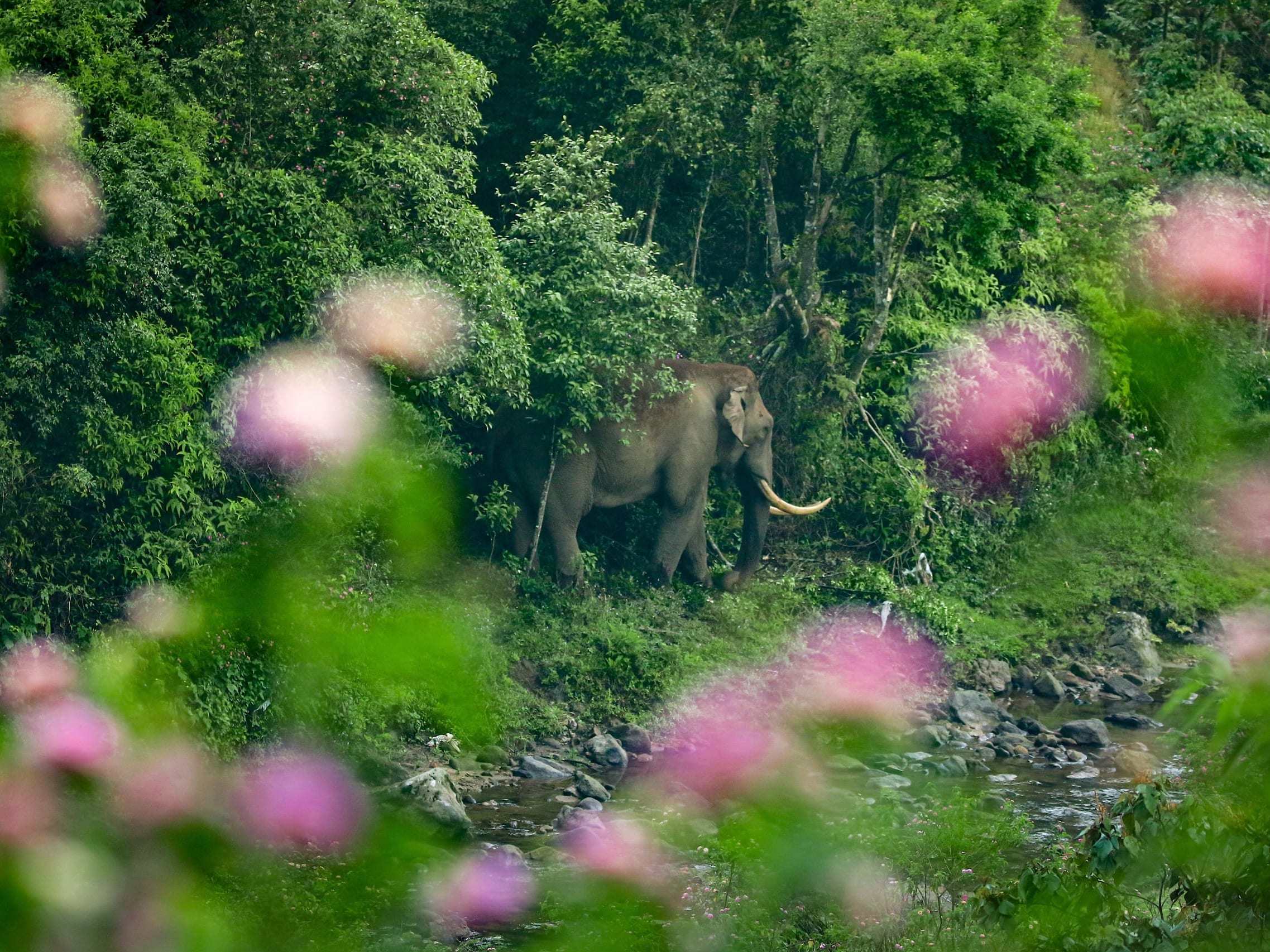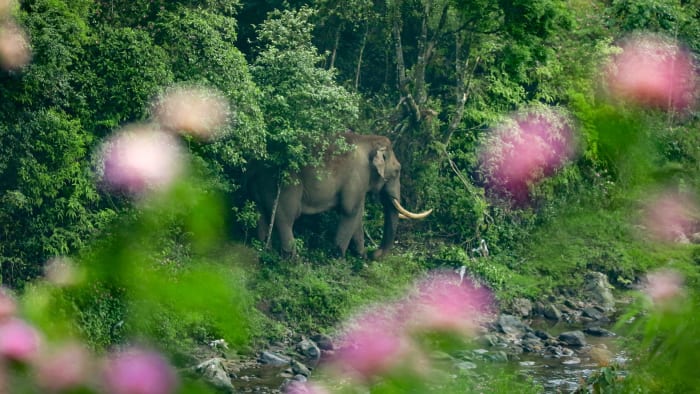 Listen to this article
•
15:34 min
Listen to this article
•
15:34 min
In early 2000, Ankila Hiremath accompanied a team of researchers visiting Karnataka’s BR Hills. Until then, she only knew the pink and yellow smudged flowering plant Lantana camara to be a hedge shrub that commonly occurred across the neighbourhoods of Delhi when she was growing up.
The field trip, however, changed this for her. What she knew as an ornamental plant was perceived as one of the biggest threats by the residents of BR Hills, where these plants are replacing the native biodiversity and changing the ecological composition of the area. “This is a completely different beast. I discovered Lantana growing several metres tall, even behaving like a climber, clambering to treetops,” says Hiremath, adjunct senior fellow at Ashoka Trust for Research in Ecology and the Environment (ATREE) who has spent several years studying this and other highly invasive plants.
“While anything new in a geographical region is considered alien or non-native, but when it starts having a negative social, ecological, or health impact, they are categorised as invasive species,” says Alok Bang, an evolutionary biologist at Azim Premji University.
The 2023 Intergovernmental Platform of Biodiversity and Ecosystem Services (IPBES) report categorises 37,000 species as alien or non-native, 10 per cent of which are invasive globally. “When the alien species start establishing populations or extending their ranges, are they categorised as invasive,” Bang clarifies, adding that they are likely to be distributed at a wider geographical level and have a broader impact than regular plant species.
Cover photo: Megaherbivores such as elephants can help manage invasive alien plants in particular ecosystems, according to a study published in 2023. Photo: Sebinster Francis
Primary threats
According to the National Tiger Conservation Authority’s (NTCA) 2022 tiger census report, 22 per cent of the country’s natural areas were invaded by “high-concern alien invasive plants,” while 65 per cent were susceptible to future invasions. These numbers are alarming, given the threats that invasive plant species pose.
“Once they find a favourable ecosystem, they monopolise resources like soil and water,” says Bang. They compete with native species in attracting frugivorous birds, enabling the dispersal of their fruits and seeds, and becoming widespread. This has emerged as a major conservation concern, observes Hiremath.
As per Ninad Mungi, an ecologist at Aarhus University, Lantana can change its traits to suit the environment it invades. “It tolerates different soils and atmospheres than it did in native regions,” explains Mungi. While certain environments, such as dense evergreen forests, can resist invasions because of their diversity and relative intactness, the experts agree that disturbed ecosystems or those fragmented by roads or infrastructure were more likely to be invaded. “Disturbances provide a conduit for the arrival of invasive species, and often they are the first ones to establish a foothold,” says Hiremath.
“In the biosphere reserves of the Nilgiris, such as Bandipur, Nagarahole and Mudumalai, there is a high density of Lantana. This causes high competition among these plants and native species, resulting in the decline of the former,” states Mungi.

These plants also pose a disadvantage to humans. As per Hiremath, while black wattle in the Nilgiris uses more water, leading to less stream flow, Lantana is known to stem the regeneration of species that communities rely on for livelihoods. “The environments have become more dangerous because the dense understories formed by invasive species reduce visibility and increase the likelihood of chance encounters with wildlife,” states Hiremath, referring to how traditional communities who rely on natural resources are disadvantaged.
In the last six decades, these species were found to cost India $127.3 billion across sectors such as fisheries, agriculture, health, social welfare, etc. A 2022 assessment of these costs found that western India accounted for 87.5 per cent or $616 million of these costs, followed by southern and northern India at $64 million and $24 million, respectively.
Ecosystem engineers
In some ecosystems, these plants change their habitats completely. “When woody invasive plants come into grasslands, they do not just spread at the cost of native biodiversity, but the grasslands become a woodland,” states Hiremath, elaborating on how a different environment is created.
“The Himalayas, Western Ghats, etc., have very specific riverine systems or forest types. With Lantana invasions throughout the country, in some sense, these ecosystems are being homogenised,” Bang points out. He elaborates that a diverse range of ecosystems will be replaced by something similar throughout. “When the diversity of the geographical distribution of plants and animals is compromised, it threatens the species inhabiting the ecosystem,” Bang says. This is likely to considerably reduce the biodiversity across the country.
Illustrating the magnitude of the problem, Bang says the 2019 IPBES report has identified these invasive species as one of the top drivers of biodiversity decline. It is ranked at the same level as environmental disasters such as overexploitation of species, land and sea use changes, pollution, or climate change.
In impacting wildlife, the plants can change habitats for them. “As most invasive plants are not palatable to them, these plants alter the quality of the habitat, and the wildlife has to go looking for food elsewhere,” says Hiremath, explaining that this is likely to cause some negative human-wildlife interactions.
However, Mungi claims that a relationship between herbivores and invasive species exists. Unlike in dry regions such as Satyamangalam and Bandipur or wet evergreen forests like Kudremukh or Sharavathi, seasonally dry and seasonally wet areas are more likely to see a direct relationship between the two. This prompted Mungi and his team to study the possibility of an effective or scalable solution.
A possible solution
As one of the signatory countries to the Convention of Biological Diversity (CBD), India’s adoption of the Aichi Biodiversity Targets holds the country accountable for identifying, controlling, and eradicating invasive alien species. This also includes implementing measures to prevent their introduction and spread.
In the recently published study titled “Megaherbivores provide biotic resistance against alien plant dominance,” Mungi and his coauthors studied the relationship between the two to see how the animals can be leveraged as a solution against these invasions.

Megaherbivores are herbivores whose body mass equals or exceeds 1,000 kg and are crucial for ecosystems. In reference to this, Mungi explains how elephants are known to alter ecosystems, change vegetation, and disperse plants to longer distances. Further, megaherbivores have diverse dietary requirements because of their size, which makes them more adaptive. “They can tolerate various species that smaller animals cannot. Hence, they might not have a problem if we change their menu a little by adding a few alien species to the mix,” Mungi adds.
“Particularly in the summer season, the megaherbivores were found to be consuming invasive plants a lot,” states Mungi. While the natural diet of these animals is native species, the alien species entered their diet only in the last 300-500 years, and the authors found the animals had no problem consuming them.
He further recollects how rhinos in Kaziranga or the sambar deer or gaur in dry deciduous systems consume Lantana leaves. Megaherbivores trampling these invasive plants was an added advantage. “Hence, the resistance faced by the invasive plant species is from increased competition from native plants and help from animals,” Mungi maintains.
It was also found that in the case of herbaceous invasive plants or plants that had no persistent woody stems, the megaherbivores kept a control on them. “However, in the case of woody thicket forming invasive plants, the impact of the herbivores started to decline,” he says. Hence, while megaherbivores can help maintain these areas, the plants need active management to bring down the density of invasions, he adds.
While there is no single solution to the complex problem of biological invasions, Mungi points out that while megaherbivores are not a cure-all solution, they can be leveraged contextually. “It brings timely evidence for the importance of nature-based solutions in the place of human-intensive solutions that are currently used,” he concludes.
Photo sources: wooden handicrafts, BRT tiger reserve










